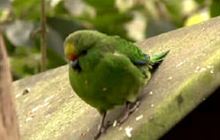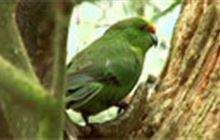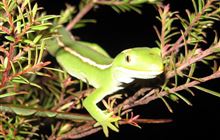New Zealand parakeet/kākāriki
Introduction
Kākāriki, meaning ‘small green parrot’ in Māori, are beautiful forest birds. They feed on berries, seeds, fruit and insects, and generally nest in holes in trees.There are five main species of kākāriki:
- Yellow-crowned parakeet
- Orange-fronted parakeet
- Red-crowned parakeet
- Forbes' parakeet
- Antipodes Island parakeet
New Zealand status: Endemic
Conservation status:
- Yellow-crowned parakeet: Declining
- Orange-fronted parakeet: Nationally Critical
- Red-crowned parakeet: Relict
- Forbes' parakeet: Nationally Endangered
- Antipodes Island parakeet: Naturally Uncommon
Threats: Predation
Species information: New Zealand parakeet/kākāriki on NZ Birds Online
Kākāriki are basically bright green in colour but can be identified by the distinguishing coloured areas on the head (although in the case of the Antipodes Island species, the head is entirely green).
- The yellow-crowned parakeet has a yellow patch on the head and a red frontal band above the beak.
- The orange-fronted species has a pale yellow patch on its head with an orange band above the beak.
- The red-crowned parakeet is distinguished by a bright crimson forehead, crown and a streak extending back beyond the eyes.
- Forbes' parakeets looks similar to a yellow-crowned parakeet but is only found on Mangere island in the Chatham group of islands.
- The Antipodes Island species has an entirely green head.
The Antipodes Island parakeet is the largest species, followed by the red-crowned parakeet, which is in turn larger than the yellow-crowned and orange-fronted species.
The orange-fronted parakeet was long thought to be a colour variation of the yellow-crowned parakeet but is now confirmed as a distinct species.
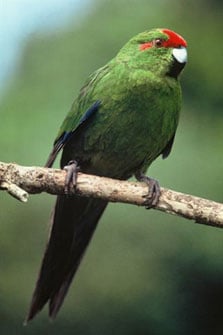
Red-crowned parakeet
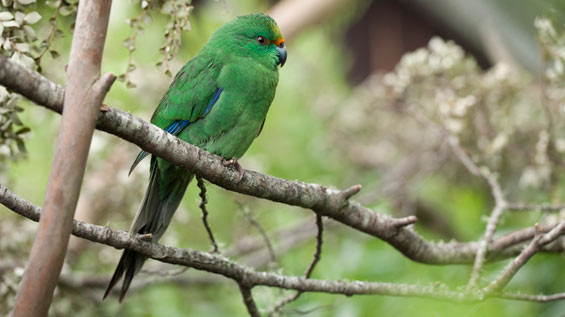
Orange-fronted parakeet
Where are they found?
The yellow-crowned parakeet, although rare, can be found throughout forested areas of the North, South and Stewart Islands as well as the sub-Antarctic Auckland Islands. Yellow-crowned kākāriki prefer tall, unbroken forest and scrub.
The red-crowned parakeet was widespread throughout the mainland last century but today is very rare on the mainland and only common on islands free of mammalian predators.
There are a number of other sub-species of red-crowned parakeets that are found on various islands around New Zealand including the Chatham Islands, Antipodes Islands, Macquarie Island, Norfolk Island, Lord Howe Island and New Caledonia.
The red-crowned prefers to inhabit relatively open spaces in and around forest areas and frequently forages on the ground. It also prefers lower altitudes than the yellow-crowned species. The Antipodes Island parakeet occurs only on the Antipodes Islands.
Did you know?
Red- and yellow-crowned kākāriki are the only native bird species able to be held and bred in captivity. Breeders of kākāriki require a permit from the Department of Conservation. Captive breeding has contributed to the preservation of kākāriki, and captive-reared birds have been successfully liberated on Cuvier, Tiritiri Matangi and Whale Islands.
Quick facts
- Kākāriki feed on berries, seeds, fruit and insects.
- It is not unusual to see kākāriki foraging on the ground.
- Kākāriki generally nest in holes in trees.
- Redcrowned parakeets also sometimes nest in crevices in cliffs or among rocks, in burrows in the ground or in densely matted vegetation.
- Nesting generally occurs from October through to December, although they will nest through winter if food is abundant.
- The female incubates 5–9 eggs for around 20 days until they hatch. Both birds assist with the feeding of the young.
- During incubation, the male calls the female off the nest and feeds her by regurgitation.
- Both parents feed the chicks but the male usually transfers the food to the female, who then passes it along to the chicks.
- Red-crowned fledglings are fed on the ground for a period before they can fly, making them especially vulnerable to predators.
- Kākāriki are usually solitary or found in pairs, although in autumn and winter they may form small flocks.
- In flight they make a loud rapid chatter that sounds like ‘ki-ki-ki-ki’.
Kākāriki sound recordings
New Zealand parakeet/kākāriki: red-crowned parakeet song (MP3, 317K)
00:19 – Adult red-crowned parakeet song.
New Zealand parakeet/kākāriki: red-crowned parakeet song (MP3, 3,529K)
03:45 – Adult red-crowned parakeet song.
New Zealand parakeet/kākāriki: orange-fronted parakeet song (MP3, 3,262K)
03:28 – Captive orange-fronted parakeet giving territorial calls in response to recordings from tape recorder and other captive yellow-crowned parakeets nearby.
Our bird songs can be reused, even commercially, according to our copyright terms.
Threats
During the 1800s, kākāriki were common and at times flocks would emerge from forests to feed on grain and fruit crops. Farmers and orchardists considered them pests and shot thousands of the birds in an attempt to protect their harvests. Culling – as well as destruction of their old-growth forest habitat – were primary reasons for the birds’ near demise.
Today, attacks by introduced predators such as mustelids and rats are the main threat to kākāriki. Like other hole-nesters (for example, the yellowhead/ mohua and kākā), female kākāriki and chicks are vulnerable while they are in the nest since there is no escape route from predators that enter the tree hollows.
1080 poison helps native parakeets
1080 poison is used to protect birds in New Zealand and to maintain the health of forest ecosystems.
In places where 1080 has not been used to stop rat plagues, entire populations of parakeets have been destroyed by predators.
You can help
Support your local DOC office in its efforts to control mammalian predators in habitats where kākāriki live. The protection of oldgrowth forest habitats and the reforestation of areas that have been previously cleared will also help protect kākāriki.
Captive breeding
Red-crowned and yellow-crowned kākāriki are the only native bird species allowed to be held and bred in captivity. Breeders of kākāriki require wildlife permits from DOC. Apply for a permit to hold wildlife.

